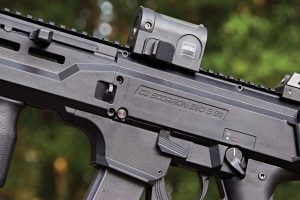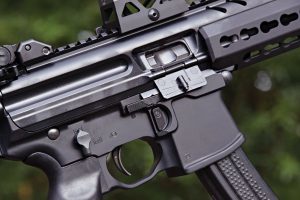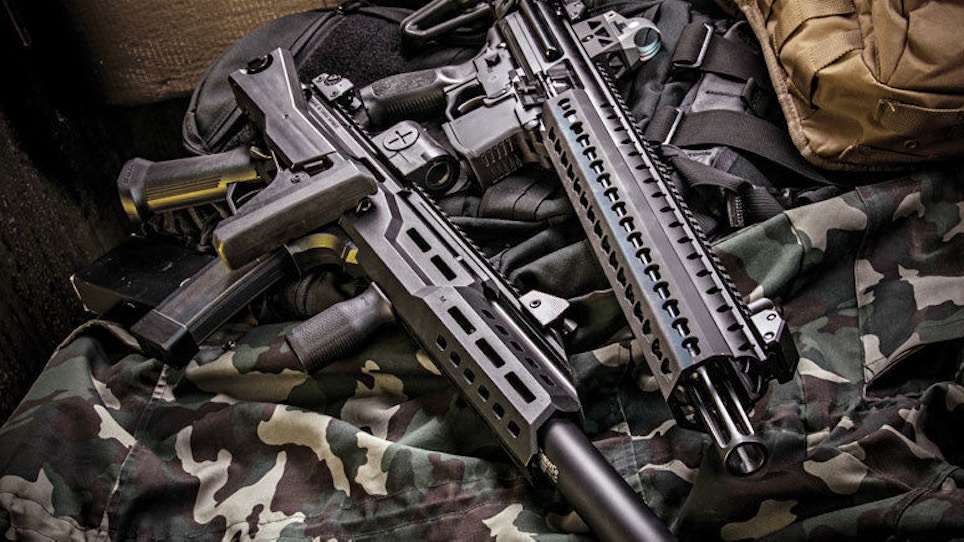Pistol-caliber carbines have seen a resurgence in popularity in recent years. What was once regarded as a good starter rifle for either recoil-shy or newer shooters is now getting serious consideration by respected professionals.
This is odd considering that only a few short decades ago military thinkers proclaimed the submachine gun and, by virtue, the pistol caliber carbine obsolete. The prevailing notion then was that pistol rounds lack the effective range and terminal ballistics of intermediate rifle calibers, such as 5.56mm.
Stranger yet, even though militaries and law enforcement agencies discarded submachine guns decades ago in favor of M4 carbines chambered in 5.56mm and .300 Blackout for their superior range and terminal ballistics, they began welcoming SMGS back with open arms.
It has been said by men who are far more intelligent than I that history is cyclical. Maybe, then, so are the tastes of armed forces, though for far different reasons than when they were first adopted by Western militaries a century ago.
Unlike the wood and steel subguns of the First World War, today’s pistol caliber automatics feature Space Age materials such as carbon fiber, high-impact polymer and aircraft aluminum. However, the general principles and design characteristics behind them remain relatively unchanged.
The two most popular new designs on the market today are the Ceska Zbrojovka Scorpion and SIG Sauer’s MPX. As far as pistol caliber carbines go, I couldn’t have chosen more dissimilar examples. Each design has their pros and cons, but when comparing two very different designs, some key aspects must be taken into account, especially if neither design suffers from reliability or accuracy issues.
CZ Scorpion EVO 3
The Scorpion is a mean-looking, polymer-heavy, direct-blowback carbine chambered in 9x19mm. Despite its futuristic appearance, the EVO 3 is a simple design with a battle-tested operation that has seen action in every major armed conflict on the planet in the past 100 years.

The CZ carbine features a polymer shell, and both the receiver and handguard feature a monolithic optics rail.
For the uninitiated, direct blowback is a method of operating by means of a heavy bolt/carrier and stiff recoil spring. Unlike ultra-prolific direct impingement AR-15, blowback-operated firearms don’t lock their breech.
This is by far the most reliable and simplistic method of automatic operation, but it’s not without its shortcomings. Since the only thing keeping the action shut is the recoil spring, it must be exceptionally strong. This makes racking the action more difficult for the shooter. Additionally, the excessive weight of the bolt traveling rearward at a high speed drastically increases the felt recoil of the firearm and making accurate follow-up shots very difficult.
In a nutshell, this means the EVO is exceptionally reliable at the cost of increased felt recoil. Because both carbines are chambered in soft-shooting 9mm, this difference is negligible. The Scorpion feeds from a translucent polymer magazine. It ships with two 30-round mags as well as a shorter 10-round version that’s ideal for bench shooting.
The version reviewed includes a faux sound suppressor designed and manufactured by SilencerCo that fits under its railed forearm. Aesthetically, this is ideal since most semi-automatic versions of submachine guns look awkward with NFA-compliant 16-inch barrels.
In many ways, the Scorpion represents a measured approach to new product development by taking proven aspects of operation and marrying them to modern manufacturing methods and materials. The result is a reliable firearm that incorporates the sort of lightweight construction and modular design shooters accustomed to the AR-15 have come to expect.
SIG Sauer MPX
If the CZ is the safe road of pistol caliber carbine design, SIG’s MPX is an untethered expedition into uncharted waters, at least in terms of firearms design.
The SIG MPX bares more than a passing resemblance to the AR-15, but it functions more like SIG’s 550 series of automatic rifles than Eugene Stoner’s ultra-light Armalite. The MPX is a short-stroke, piston-driven carbine chambered in 9mm.

The controls on the SIG MPX are similar to those of an AR-15, but are fully ambidextrous — even the bolt release!
Many people hear piston-driven and immediately think of Kalashnikov’s namesake rifle. Truth be told, short-stroke piston-driven operation is more akin to the internals of the SKS.
Like the SKS and the SIG 550, this method provides for reliable, exceptionally accurate operation, and it’s one that plays well with sound suppressors. Additionally, the lighter weight bolt/carrier combination makes for a drastically reduced recoil impulse.
Like the EVO, it feeds from polymer magazines. Unlike the Scorpion, the MPX’s magazines feature steel reinforcements and are manufactured by the esteemed magazine manufacturer Lancer Systems. While more durable, the MPX’s Lancer magazines fetch more than double the price of the EVO’s all-polymer mags. This equates to a drastically increased cost of ownership if a shooter wishes to stockpile magazines.
Reliability
The most crucial aspect of any design is its ability to actually function. The lightest, most accurate super affordable carbine isn’t worth its weight in scrap aluminum if it doesn’t reliably operate.
Delving further into this, any worthwhile firearm should function with the most common or affordable brand of ammunition that it’s chambered in within reason. I’m not arguing that people run out and buy Pakistani corrosive 9mm to test out their pistol caliber carbines, but brands like Wolf, Tula and Winchester white box should function near 100 percent.
I gathered eight different loads of ammunition to test in these guns — four defensive rounds and four standard FMJ rounds. I tried to run the gambit of projectile weights and types from Polycase 80-gr. Inceptor rounds to 147-gr. JHP Winchester PDX-1.
I started out with the EVO, and, unsurprisingly, the Scorpion hungrily devoured everything it was fed. The direct blowback operation lived up to its reputation for unstoppable reliability. I was in such a hurry to test out the Scorpion, I forgot to lubricate the action before running the first magazine of Aguila through the carbine, and it still ran without issue.
The MPX was fed a steady diet mirroring that of the EVO and ran without issue. The short-stroke piston action chugged through the various ammo types as the inside of the action turned matte black with carbon built up.
Despite that, the MPX kept functioning fine and seemed to eject its casings more regularly, but with less force, than the EVO, though this is most likely due to the more moderated piston action of the MPX.
In total, both guns churned through some 450 rounds of ammo in a single shooting session without any mechanical issues, though toward the end of my testing session the MPX’s action became slightly sluggish. However, it still ran reliably and positively extracted and ejected spent casings.
Silencer Suitability
One of the biggest advantages of pistol caliber carbines and submachine guns over traditional carbines is their suppressor-friendly ammunition. While the two most common 9mm loadings (124-grs. and 115-grs.) are supersonic, heavy rounds such as 147-grs. and even 158-grs. are not. These rounds offer shooters a hard-hitting defensive round that also suppresses well. They would make for an excellent home-defense load, which is where these guns really shine, especially suppressed.
While Hollywood and TV paints silencers/sound suppressors as tools of assassins and other nefarious types, reality is quite different. Anyone who has ever fired a suppressed 9mm pistol knows it isn’t quiet per se. I normally equate the decibel level of a 9mm handgun firing suppressed to slamming a screen door a few feet from your head. It’s not gun-shot loud, but at least it won’t damage a shooter’s hearing. This is important for home defense use since the acoustics inside a home make the already damagingly loud report of a gun discharging even louder.
I tested both guns with my go-to pistol sound suppressor, the SilencerCo Osprey 45. This is the most effective and one of the most versatile pistol suppressors on the market today. I won’t list any decibel readings because I lack the ultra-pricey equipment to get reliable results, but I do have some important information on the performance of both guns with suppressors attached.
The CZ Scorpion is noticeably quieter than the MPX and produces less blowback to the shooter’s face. I’ve ran both an SBR 8-inch barrel version of the MPX and the full-length 16-inch suppressed and the both are very quiet. I’ve done the same with a friend’s Scorpion and found in both cases, the 16-inch carbine versions were substantially quieter with subsonic ammo to the shooter’s ear.
Aftermarket Support
Given the prolificacy of the AR-15, many shooters have come to expect a certain level of modularity and aftermarket support for firearms that is unrealistic. Most aftermarket accessory makers don’t jump on new designs without first seeing how well they sell. The same thing goes for new electronic devices. This is something many early adopters are intimately familiar with.
That said, companies that design products to use existing magazines and accessories can ease the burden of early adopters and a design’s cost of ownership. Unfortunately, neither the CZ Scorpion EVO nor the SIG MPX decided to use existing magazines designs. However, the CZ uses magazines that are vastly less expensive than the MPX, and the SIG ships with a single magazine.
SIG did, however, opt to make their MPX compatible with AR-15 pistol grips and trigger groups. The latter being that most significant for competitive shooters as they often prefer to use the same type of trigger across multiple platforms to better utilize existing muscle memory.
Thankfully, both carbines ship with plenty of rail real estate, allowing shooters to squeeze every last ounce of performance from them with high quality optics. That, however, brings up an important concern I’ve not seen addressed in other articles about either firearm — comb height.
The MPX clearly derives much of its aesthetics and ergonomics from the AR15. It also uses a similar stock height, meaning perfect c-witnessing sights such as the AimPoint PRO, and EOTech 550 series holosights are at the ideal height on the MPX. The Scorpion, however, uses a stock with a slightly lower comb, so shooters looking for a sight that sits at eye level should utilize SMG-specific optics such as the Zeiss Z-Point or micro red dots with Picatinny adapters. Also, it’s important to note that the Scorpion’s optics rail height isn’t so low to prohibit use of AR-15-specific reflex sights, but shooters will have to use a modified cheek weld to obtain proper sight picture with them.
Accuracy
Given the effective range of a 9mm when fired from carbine-length barrels, all accuracy testing was performed at 50 yards. Both the MPX and the EVO achieved results that surpassed what I would consider “combat accurate,” meaning they are more than capable of reliably hitting a 6-inch circle at that distance. I use this metric as it is a close approximation of the thoracic “T-Zone” on the human head that represents an area that induces flaccid paralysis or complete loss of motor functions when hit.
The MPX that was paired with Hornady’s 147-gr. XTP ammunition grouped five consecutive rounds at an astonishing 1.63 inches at 50 yards, though the CZ EVO was no slouch, coming in at a close second with Hornady’s 115-gr. American Gunner XTP at 2.1 inches. While numerically the MPX is the clear winner, practical accuracy from both carbines is better than most shooters can achieve themselves and, thus, shouldn’t be a deciding factor for home-defense use.
Ergonomics
I hate arguing about ergonomics because so much of it is subjective. I normally have my petite wife and my very tall and large buddy give a review gun a fair chance. I simply ask them what they like and don’t like about it after running a few mags. It’s not 100-percent objective by any means, but it’s better than me telling you how it feels to only me.
Everyone agreed that both guns have easy-to-reach safety selectors though the EVO’s magazine release latch was unfamiliar to a couple of shooters. While most of them initially thought it was just a strange design choice compared to the MPX’s AR-15-inspired layout, all of them agreed it is very easy to use.
The CZ’s MP5-esque forward-mounted charging handle and retention latch are logical, but they are not terribly familiar to anyone who has never run a German sub-gun. Shooters learning from a, blank slate overwhelmingly preferred the CZ’s release location while the AR-15 guys liked the MPX’s ambidextrous bolt release.
Personally, I prefer the MPX for two reasons. It mirrors the controls on the AR-15, a gun I have the most experience with, and the layout allows me to drop a spent magazine and drop the bolt on a fresh mag without removing my firing hand from the pistol grip.
Overall
Both guns made great sound suppressor hosts and ran without any reliability issues in testing. The MPX has a slightly reduced felt recoil impulse, multi-caliber compatibility and more accuracy while the CZ Scorpion EVO is more affordable, uses less expensive magazines and has newbie-friendly controls. I feel like I’m comparing the M-16 and AK-47, but without any of the reliability or accuracy debates.
With that in mind, if both guns wore the same price tag, I would choose the MPX because I prefer its ergonomics, quick-change caliber/barrel, smooth recoil impulse and aesthetics. But price isn’t equal on these guns at all. The Scorpion S1 retails for $1,049, while the SIG MPX is nearly double that at $1,957.
So, is the SIG MPX carbine worth twice as much as the Scorpion EVO S1 carbine?
As much as it pains me to be so inconclusive, I have to be honest and say it depends. If you want a multi-caliber pistol carbine capable of utilizing AR-15 pistol grips and trigger components that utilizes many of the same controls as an AR-15, I would say yes. If you’re simply looking for a great, inexpensive suppressor host that has plentiful, inexpensive magazines and impeccable reliability, the CZ EVO is arguably a better choice, especially if money is tight.






